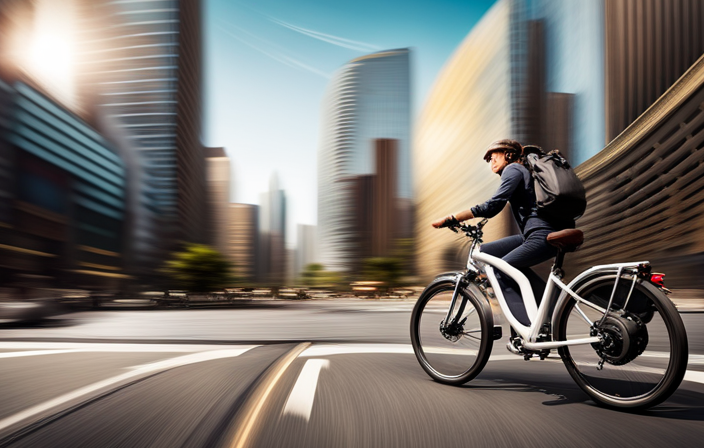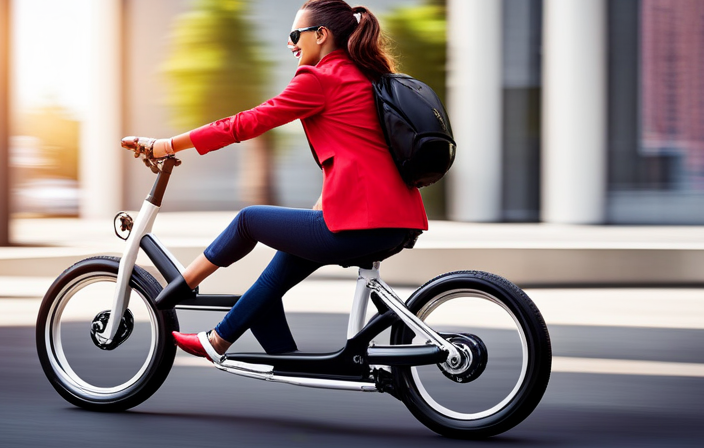Considering purchasing an electric bike, are you? Well, hold on tight because things are about to get exciting.
You see, there’s a fine line between an electric bike and a motorcycle, and it’s not as clear-cut as you might think. In this article, I’ll be diving into the nitty-gritty details of what separates these two modes of transportation.
From design and structure to legal requirements and riding experience, we’ll explore it all.
So, sit back, relax, and let’s unravel the mysteries of when an electric bike becomes a motorcycle.
Key Takeaways
- Electric bikes are considered motorcycles when they exceed a certain speed limit and require a license to operate.
- Understanding electric bike classification is important to define whether it falls under motorcycle regulations or bicycle regulations.
- Design and structure differences, such as engine size and materials used, help differentiate electric bikes from motorcycles.
- Compliance with local authorities’ regulations, including licensing and registration, is necessary for legal riding on public roads.
Definition of an Electric Bike
An electric bike is considered a motorcycle when it exceeds a certain speed limit and requires a license to operate.
The classification of electric bikes varies depending on the country and their regulations. In some places, electric bikes are classified as bicycles as long as they have a maximum speed of 20 mph and a motor power of 750 watts or less. However, in other regions, the classification may differ, with stricter speed limits and wattage requirements.
These regulations aim to ensure the safety of riders and other road users. It is important to be aware of the specific regulations in your area to determine whether your electric bike falls under the classification of a motorcycle.
Understanding the classification of electric bikes is a crucial step in determining the definition of a motorcycle.
Definition of a Motorcycle
The definition of a motorcycle includes having an engine and two wheels. In terms of motorcycle licensing and regulations, it is important to distinguish between motorcycles and electric bikes.
While electric bikes may have two wheels, they do not necessarily have an engine in the traditional sense. Instead, they are powered by electric motors. This distinction becomes crucial when it comes to licensing and regulations.
In many jurisdictions, electric bikes are classified as bicycles rather than motorcycles, which means that they are subject to different rules and regulations. These regulations often involve restrictions on speed and power output.
Understanding the differences between motorcycles and electric bikes is essential for ensuring compliance with licensing requirements and regulations.
Transitioning into the subsequent section about key differences in design and structure, it is important to note that the distinction between motorcycles and electric bikes goes beyond just the presence of an engine.
Key Differences in Design and Structure
One major difference in design and structure is that motorcycles typically have larger engines than electric bikes. While electric bikes are powered by electric motors with lower wattage, motorcycles are equipped with combustion engines that provide greater power and speed.
Another key distinction is the frame materials used in electric bikes compared to scooters. Electric bikes often use lightweight materials such as aluminum alloys or carbon fiber to maximize efficiency and maneuverability. On the other hand, scooters typically have sturdier frames made from steel or other heavy-duty materials to support their larger engines and provide stability.
Understanding these differences in design and structure helps to differentiate between electric bikes and motorcycles. Moving forward, it is important to explore the legal requirements and regulations associated with electric bikes and motorcycles.
Legal Requirements and Regulations
When it comes to the legal requirements and regulations surrounding electric bikes, two key points that need to be addressed are licensing and registration, as well as the use of helmet and safety gear.
From a knowledgeable and analytical perspective, it is important to understand the specific laws and regulations in your jurisdiction regarding the licensing and registration of electric bikes.
Additionally, the use of proper helmet and safety gear is crucial for ensuring the safety of the rider, and it is essential to abide by any regulations or requirements set forth by local authorities.
Licensing and Registration
If you want to ride an electric bike that meets the classification of a motorcycle, you’ll need to consider licensing and registration.
Electric bike licensing requirements vary depending on the jurisdiction, but in most cases, you will need to obtain a motorcycle license or endorsement. This typically involves passing a written exam and a skills test.
As for registration, electric bikes that meet the criteria of a motorcycle are usually required to be registered with the Department of Motor Vehicles (DMV) or a similar governing body. This process involves providing proof of ownership, paying registration fees, and obtaining a license plate or tag for your electric bike.
Once you have completed the necessary licensing and registration procedures, you can legally ride your electric bike on public roads.
Now, let’s discuss the importance of wearing a helmet and safety gear.
Helmet and Safety Gear
After discussing the requirements for licensing and registration of electric bikes, it is crucial to emphasize the importance of wearing a helmet and appropriate safety gear when riding these vehicles.
Helmets serve as the first line of defense in protecting our heads from potential injuries. With the increasing popularity of electric bikes, it is essential to prioritize safety by investing in a high-quality helmet that meets safety standards.
In addition to helmets, riders should consider wearing elbow and knee pads, as well as protective clothing to minimize the risk of abrasions and fractures in case of accidents. It is recommended to choose safety gear that is specifically designed for electric bike riders, taking into account the unique features and potential hazards associated with these vehicles.
Transitioning into the subsequent section about electric bike classifications, it is important to understand how these categories are defined and regulated.
Electric Bike Classifications
To determine if an electric bike is classified as a motorcycle, you should consider factors such as speed and power. Electric bike speed can vary greatly depending on the model and motor capabilities. Some electric bikes can reach speeds of up to 28 miles per hour, while others may have a top speed of only 20 miles per hour.
Additionally, the electric bike range is an important factor to consider. The range refers to the distance the bike can travel on a single charge. Some electric bikes have a range of 40 miles or more, allowing for longer rides without needing to recharge.
Considering these factors will help determine if an electric bike falls into the motorcycle classification. Moving on to motorcycle classifications…
Motorcycle Classifications
Let’s dive into the different classifications for motorcycles.
When comparing electric bikes to scooters, there are some key distinctions to consider.
Electric bikes, also known as e-bikes, are bicycles with an integrated electric motor. They typically have pedal-assist features, meaning the motor provides assistance while you pedal.
On the other hand, scooters are powered by a motor and do not require pedaling.
One of the benefits of electric bikes is their ability to provide a more efficient and eco-friendly mode of transportation compared to scooters. They have a lower environmental impact and can also contribute to reducing traffic congestion.
Transitioning into the next section about electric bike and motorcycle features, it is important to understand the differences between these classifications.
Electric Bike and Motorcycle Features
When it comes to electric bikes and motorcycles, there are several key features to consider.
First, the use of pedals and human power is an important aspect to examine. Some electric bikes have pedals that can be used for additional power, while others rely solely on the motor.
Second, the engine type and fuel is another crucial factor to explore. Electric bikes are powered by batteries, while motorcycles can be either electric or fuel-powered.
Finally, the transmission and gearing of these vehicles also vary. Electric bikes typically have a single-speed transmission, while motorcycles can have multiple gears for different riding conditions.
Overall, understanding these features is essential for making an informed decision when choosing between an electric bike and a motorcycle.
Pedals and Human Power
The electric bike’s pedals allow for human power assistance. This feature not only makes electric bikes more efficient, but also promotes human-powered transportation. Here are five reasons why the combination of pedals and electric power is a game-changer for transportation:
-
Increased range: By pedaling along with the electric assist, riders can extend the range of their electric bikes, making them suitable for longer commutes or leisurely rides.
-
Health benefits: The ability to pedal means that riders can get exercise while enjoying the convenience of electric power, promoting a healthier lifestyle.
-
Reduced environmental impact: By combining human power with electric assistance, electric bikes become even more eco-friendly, reducing emissions and dependence on fossil fuels.
-
Cost savings: Pedaling allows riders to conserve battery power, resulting in longer battery life and ultimately, cost savings.
-
Flexibility: With the option to use the pedals, riders have the freedom to choose how much assistance they need, making electric bikes adaptable to different fitness levels and terrain.
With the efficiency and human-powered capabilities of electric bikes established, let’s now delve into the next section about engine type and fuel.
Engine Type and Fuel
One advantage of using a combustion engine instead of an electric motor is the availability of different fuel options. Combustion engines can run on gasoline, diesel, ethanol, or even natural gas, giving riders the flexibility to choose the fuel that suits their needs. This is particularly beneficial when it comes to engine power and fuel efficiency.
Combustion engines can generate higher levels of power, allowing motorcycles to achieve faster speeds and handle tougher terrains. Additionally, advancements in engine technology have resulted in improved fuel efficiency, meaning that motorcycles with combustion engines can travel longer distances on a single tank of fuel.
Transitioning into the subsequent section about transmission and gearing, the choice of engine type and fuel can greatly impact the performance and efficiency of a motorcycle’s transmission system.
Transmission and Gearing
You can optimize your riding experience by understanding how transmission and gearing work together. The transmission of a motorcycle is responsible for transferring power from the engine to the wheels. There are different types of transmissions, including manual, automatic, and semi-automatic. Each type has its own advantages and disadvantages, depending on the rider’s preference and skill level. Gearing, on the other hand, refers to the different gear ratios available in the transmission. By changing gears, you can adjust the power and torque delivery to the wheels, allowing for better acceleration or higher top speed. Understanding the gear ratios and how they interact with the transmission can greatly enhance your riding experience. In the table below, we can see a comparison of different transmission types and their gear ratios.
| Transmission Type | Gear Ratios |
|---|---|
| Manual | 1st: 3.50 |
| 2nd: 2.60 | |
| 3rd: 1.90 | |
| Automatic | 1st: 2.80 |
| 2nd: 1.80 | |
| 3rd: 1.20 | |
| Semi-Automatic | 1st: 3.20 |
| 2nd: 2.00 | |
| 3rd: 1.50 |
Understanding the different transmission types and gear ratios can help you make informed decisions when choosing a motorcycle. By selecting the right combination for your riding style and skill level, you can ensure a smoother and more enjoyable ride. In the next section, we will explore how your riding experience and skill level can further impact your choice of motorcycle.
Riding Experience and Skill Level
Riding an electric bike requires practice and skill to ensure a smooth and enjoyable experience. As with any new skill, there is a learning curve involved in mastering the riding techniques of an electric bike. Here are some key points to keep in mind:
-
Balance and Stability: Maintaining a proper balance is crucial when riding an electric bike. Practice maintaining your balance at different speeds and on different terrains.
-
Acceleration and Braking: Electric bikes have instant torque and responsive brakes. It’s important to learn how to smoothly accelerate and brake to avoid jerky movements.
-
Cornering and Turning: Mastering the art of cornering and turning is essential for navigating through traffic and tight spaces. Practice leaning into turns and maintaining control of your bike.
By honing these skills, you will enhance your riding experience and feel more confident on your electric bike.
Now, let’s transition into the next section about safety considerations.
Safety Considerations
Ensure your safety by wearing proper protective gear such as a helmet and reflective clothing. When it comes to electric bike accidents, safety should always be a top priority.
One way to enhance safety is through participation in safety training programs. These programs provide riders with valuable knowledge and skills necessary for navigating the roads safely. They cover topics such as defensive riding techniques, proper braking, and understanding traffic rules specific to electric bikes. By participating in these programs, riders can gain the confidence and expertise needed to handle various road conditions and potential hazards.
Additionally, these programs often emphasize the importance of regular maintenance and inspections to ensure the electric bike is in optimal working condition. Overall, safety training programs play a crucial role in reducing the risk of accidents and promoting safe riding practices.
Moving forward, let’s delve into the conclusion and final thoughts on electric bike safety.
Conclusion and Final Thoughts
To wrap up, it’s important to reflect on the overall significance of safety training programs in promoting responsible and cautious road behavior. Safety training programs play a crucial role in educating individuals about the rules and regulations of the road, as well as providing them with the necessary skills to navigate safely.
When it comes to electric bikes vs scooters, safety training becomes even more important. Electric bikes, with their higher speeds and greater power, require riders to be well-prepared and knowledgeable about handling these vehicles.
Here are three benefits of electric bikes:
-
Environmentally friendly: Electric bikes produce zero emissions, helping to reduce air pollution and combat climate change.
-
Cost-effective: Electric bikes are more affordable than cars, scooters, or motorcycles, making them a practical transportation option.
-
Health benefits: Riding an electric bike provides exercise, helping to improve cardiovascular health and overall fitness.
Frequently Asked Questions
Can I ride an electric bike on the highway?
Yes, you can ride an electric bike on the highway, but it depends on the legal requirements. Some states allow it, while others have specific regulations like speed limits and licensing requirements. It’s important to check your local laws before riding on the highway.
Are electric bikes more expensive than motorcycles?
Electric bikes can be more expensive than motorcycles, depending on the model and features. For example, a high-performance electric bike with advanced technology can cost more than a basic motorcycle. However, there are also affordable electric bikes and expensive motorcycles on the market. When comparing performance, electric bikes may have lower top speeds and shorter ranges than motorcycles, but they offer advantages like zero emissions and quieter operation.
Can I use an electric bike for off-roading?
Yes, you can use an electric bike for off-roading. However, it is important to ensure electric bike safety by wearing protective gear and maintaining the bike regularly to ensure its performance and longevity.
Are electric bikes more environmentally friendly than motorcycles?
Electric bikes are more environmentally friendly than motorcycles. They produce zero emissions, reducing air pollution. Additionally, they can help alleviate urban congestion by providing an alternative to cars and public transportation.
Can I modify an electric bike to make it faster?
To make an electric bike faster, there are various modifications and speed upgrades available. By installing a more powerful motor, upgrading the battery, or adjusting the controller, you can significantly increase the speed and performance of your electric bike.
Conclusion
As I bring this discussion on electric bikes and motorcycles to a close, the gears of my mind begin to whirr with thoughts.
Like the intertwining chains of a bicycle, the line between an electric bike and a motorcycle can be blurry at times. However, by exploring their definitions, design differences, legal requirements, and riding experiences, we can navigate through this winding road.
Remember, whether you choose the nimble electric bike or the powerful motorcycle, ride safely and enjoy the journey ahead.









